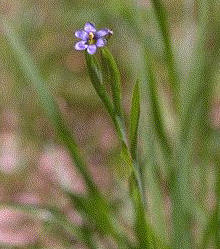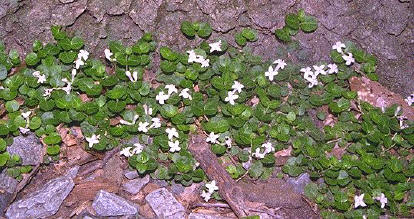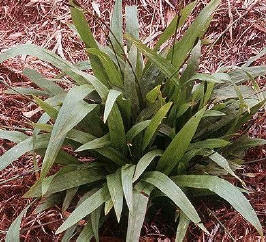Charlie Metz
Frederick County Master Gardener Program
Wintergreen (Gaultheria procumbens) makes an excellent year-round groundcover, with shining evergreen leaves, wintergreen-scented leaves and bright red berries that are edible and taste of wintergreen. This native grows well under shrubs and
flowering trees in acid soil. You may need to water it well the first year.
The native Allegheny pachysandra (Pachysandra procumbens) is another excel-lent choice, with richly patterned, two-tone leaves that persist valiantly through winter. The fragrant white flowers that appear briefly in April are followed by a
second-story layering of fresh, spring-green leaves. This is definitely not the pachysandra your aunt grew — the Japanese Pachysandra terminalis, much overused and now playing host to a variety of unpleasant pests and diseases. The multitone leaves of Allegheny pachysandra
are an artist's delight and likened to the matte finish design found on pottery.
Is the area shaded? If so, then Shuttleworth's ginger (Asarum shuttleworthii) would be a fine selection. This native evergreen plant has rounded leaves with a curious mottling that lends interest to the front edges of a garden. It blooms in spring,
but since blossoms are small, dark and low to the ground, they are easily missed. Plant Shuttle-worth ginger for texture and evergreen color. This one is a little slower to establish, but patience pays off. The cultivar `Callaway' has more variegation.
If you like the ginger-leaf shape but don't want to wait, Asarum canadense, wild ginger, spreads more rapidly and still has a beautiful dark green leaf. Wild ginger dies off in winter and re-emerges early in spring.
For long-lasting, buttery golden yellow color, try green and gold Chrysogonum virginianum. This cheery, hard-working native plant will form a nice, low, dense cover in relatively short time, all the while blooming profusely in spring and fall, with
only a slight slow-down during the heat of summer. You can divide green and gold in early spring or fall. It does well in full sun or partial shade and is quite adaptable to some of the most difficult soils, although it will do best in rich, organic soil.
|

blue-eyed grass (Sisyrinchium montanum)
|
To contrast with the green and gold, you could include blue-eyed grass (Sisyrinchium angustifolium), one of my favorites. This is a dainty, miniature member of the iris family. Its tufts of grass-like foliage terminate surprisingly in tiny little
blue flowers with yellow centers. The blooms are thickest in spring and early summer, but it is not uncommon to enjoy a full eight to 10 weeks of these deceptively delicate-looking but tough natives. Plants are easy to grow in either full sun or partial shade, and they
spread slowly to form thick clumps that can be divided, if desired, after flowering.
Another, slightly larger iris that forms a nice sweeping groundcover is the dwarf crested iris, Iris cristata. Although blooms of this native plant are larger than that of the blue-eyed grass, the entire plant is still under 6 inches tall. The
typical form has light blue blossoms in May, although a white variety is also available. The leaves form a sea of soft green arches. Although this iris prefers more moisture than blue-eyed grass, it will tolerate many years of dry conditions once established.
|

Partridge berry (Mitchella repens)
|
Partridge berry (Mitchella repens) is another native groundcover I had good results with, as long as I keep my planting of it to shaded areas. This trailing evergreen plant has shiny, oval leaves and pairs of small, intensely white flowers in spring.
The paired flowers eventually form a double berry, which is why it is also called twinberry. The scarlet berries last all summer. This is a nice plant to mix in, since it will weave its way around other plants, trailing stems forming new roots as they grow, securing and
protecting the soil.
Foamflower (Tiarella cordifolia) has become very popular lately, in part because of its reputation for being deer resistant. In my home in the Catoctin forest, deer seem to like it very much, but the good news is that foamflower just grows right back
after being grazed down to nothing. A spring-blooming ground-cover, foamflower is planted as much for its toothy, multi-colored foliage as for its conical clusters of white to pink flowers. There are many cultivars with quite a variety of foliage pat-terns, colors and
shapes.
|

Carex plantaginea
|
Ferns can also be used for a groundcover. Christmas fern is easy to grow in many different situations and will not spread too aggressively. It sends up beautiful little fiddleheads in spring and will stay green throughout winter.
And if you are looking at ferns, I have to mention at least one sedge (Carex plantaginea) plantain-leafed sedge. This native of eastern North America has unusually broad leaves and combines very nicely with ferns since it likes moisture and shade for
best growth. The wide, shiny leaves have parallel veins running like cords all along the leaf, providing a wonderful visual texture that complements the horizontal leaf pattern of the ferns.
Read other articles on garden and landscape design
Read other articles by Charlie Metz